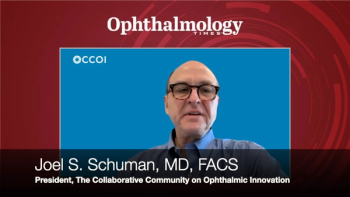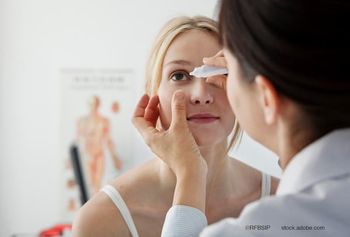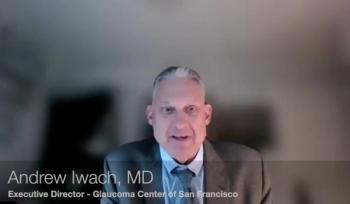
Redesigned probe for micropulse transscleral laser therapy for glaucoma proves less is more
The lower energy applications and slower sweep speeds offer marked IOP reductions in patients.
Reviewed by Syril Dorairaj, MD
The first results on the safety and efficacy of micropulse transscleral laser therapy (TLT) utilizing the latest iteration of the MicroPulse P3 Device (Iridex Corp. and Cyclo G6 Glaucoma Laser System (Iridex Corporation) were recently presented at the American Glaucoma Society Annual Meeting by Syril Dorairaj, MD, a professor of ophthalmology at Mayo Clinic in Jacksonville, Florida, with Leticia Checo, MD, and Isabella Wagner, BS.
The revised MicroPulse P3 was introduced in 2020 and represented an ergonomic redesign of the original. Additionally, Dorairaj noted that the redesign eliminates some disadvantages associated with the original MicroPulse P3, which were occasionally associated with vision-threatening complications and inconsistent outcomes.
Dorairaj explained the ergonomic differences between the revised MicroPulse P3 and the original.
“The revised MicroPulse P3 probe footplate has a scleral-matching curvature, which allows consistent laser delivery, orientation, and increased stability,” Dorairaj said. “The outcomes depend entirely on where the laser energy is concentrated during surgery. In this case, the probe can better focus on the ciliary body, where the aqueous humor is produced and where outflow occurs.”
The revised MicroPulse P3 uses an increased power of 2500 mW vs 2000 mW used with the original MicroPulse P3 probe. In addition, the duration of the laser application was decreased from 80 seconds to 50 seconds per hemisphere initially. Another consideration was the speed with which the probe was moved (ie, sweep-speed velocity) and the number of sweeps performed (ie, 3, 4, or 5 sweeps).
In the study, investigators enrolled 61 patients with a severe glaucoma diagnosis (primary open-angle refractory glaucoma, 87%; neurovascular glaucoma, 5%; glaucoma secondary to retina surgery, 3%; pseudoexfoliation, 3%; and angle-closure glaucoma, 2%). They evaluated the outcomes of micropulse TLT using 2500 mW at a 31.3% duty cycle and compared the results of 50- and 60-second applications, respectively, per hemisphere using 3 sweeps (1.3 mm/s and 1.1 mm/s), 4 sweeps (1.8 mm/s and 1.5 mm/s), and 5 sweeps [2.2 mm/s and 1.8 mm/s). The revised MicroPulse P3 probe was applied using steady pressure parallel to the visual axis, and the fiber-optic probe tip was precisely positioned 3 mm posterior to the conjunctival limbus. The probe was moved continuously along the limbus and slid back and forth. Three and 9 o’clock positions were avoided to protect ciliary neurovascular structures.
“The faster we went, the lower the efficacy was. Conversely, when we proceeded more slowly, the outcomes were generally better at reducing the IOP [intraocular pressure],” Dorairaj said.
The biggest concern was the potential for complication development because vision-threatening complications have been previously reported following use of the original MicroPulse P3 probe.
Micropulse TLT effect on IOP
Micropulse TLT delivers small thermal packets of laser energy to the ciliary body to significantly lower sustained IOP in study patients when various sweep velocities were compared.
The investigators found that more significant IOP reductions were generally associated with slower sweep-speed velocity and that faster sweep-speed velocity during micropulse TLT produced the lowest IOP reductions. When compared with baseline, the 50-second applications during 3, 4, and 5 sweeps were found to produce mean decreases in IOP of 44.9%, 56.3%, and 32.8%, respectively; the 60-second applications during 3, 4, and 5 sweeps were found to produce mean decreases in IOP of 45.5%, 48.2%, and 40.4%. The average mean IOP decrease across all treatment groups was 44.7%, and all reported IOP decreases were statistically significant.
“All patients achieved an IOP decrease of 20% or greater, and three-quarters of patients achieved an IOP of 21 mm Hg or lower,” Dorairaj explained. “About 10 of the study patients required another intervention and were managed accordingly.”
Most failures occurred in treatment groups with faster sweep velocities, suggesting that slower probe movements (ie, slower-sweep velocity) during micropulse TLT are more effective at reducing both IOP and the risk of surgical reinterventions.
“We found that the efficacy with this revised probe was far better compared with the outcomes achieved with the original MicroPulse P3 probe. In addition, no vision-threatening complications developed. However, generally following treatment with the revised MicroPulse P3 probe, some patients had a decrease in vision of 2 lines or less after 1 year of follow-up,” Dorairaj said, noting that level of vision loss occurred in 2 out of 60 patients (3.3%) with the revised MicroPulse P3 at the 1-year time point.
“During the COVID-19 pandemic, we avoided performing incisional surgeries as well as [scheduling] numerous follow-up evaluations, which was a big safety concern,” he said. “The most important factor for me regarding micropulse TLT was that it satisfied my primary goal of safety.”
Since the study, Dorairaj has modified his procedure to use 80- to 100-second applications using 4 to 5 sweeps, respectively. He explained that this modification was based on the absence of complications associated with the 60-second application.
“I have been seeing excellent outcomes in all patients,” he commented.
The IOP reductions have been sustained over almost 20 months, and 90% of patients have not required further surgical intervention.
“The procedure is safe,” Dorairaj concluded. “The application time can be increased beyond 60 seconds without complications. The sweeps are performed in a slow, steady fashion, and the production of aqueous fluid is decreased. The technique facilitates precise focusing of laser energy to obtain the greatest IOP reductions.”
Syril Dorairaj, MD
The article is adapted from Dorairaj’s presentation at the American Glaucoma Society Annual Meeting in Nashville. He has no financial interest in this subject matter.
Newsletter
Don’t miss out—get Ophthalmology Times updates on the latest clinical advancements and expert interviews, straight to your inbox.










































